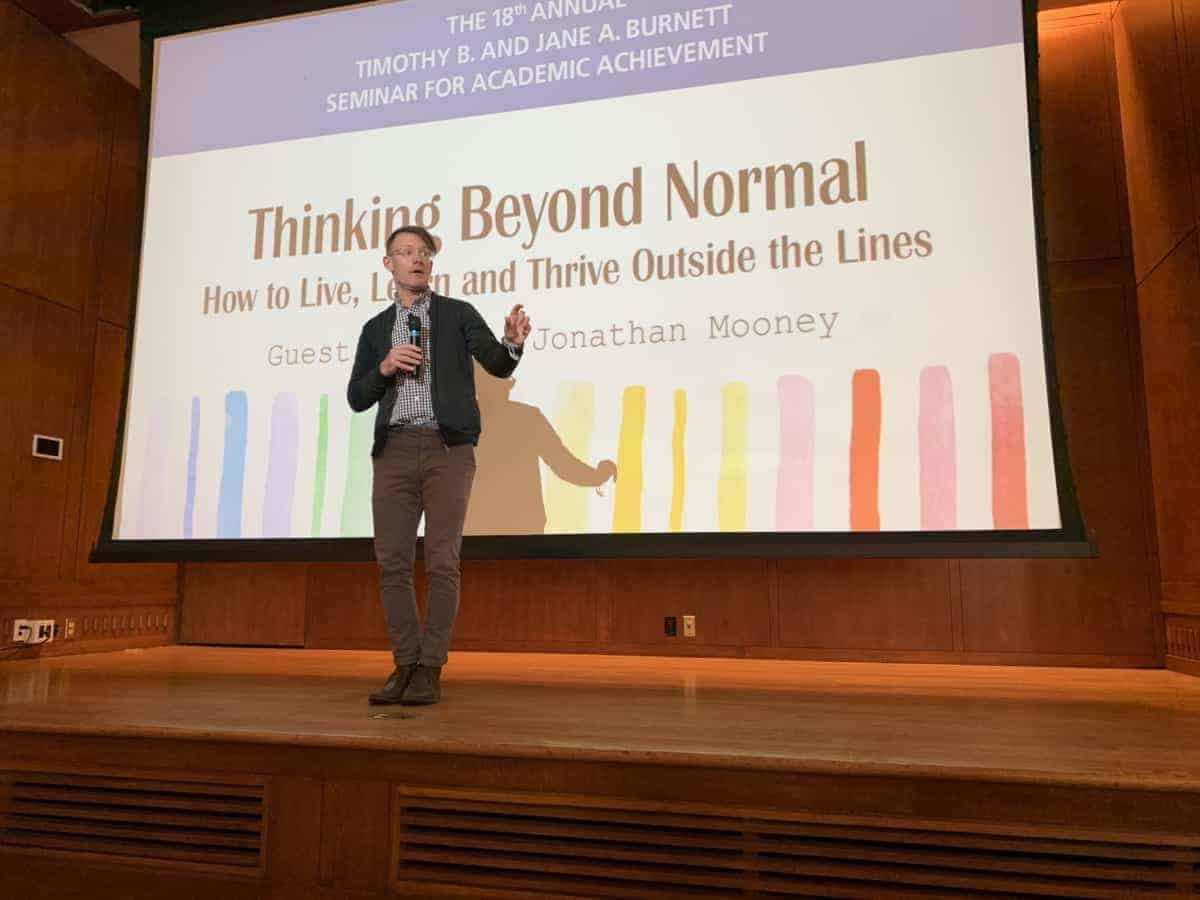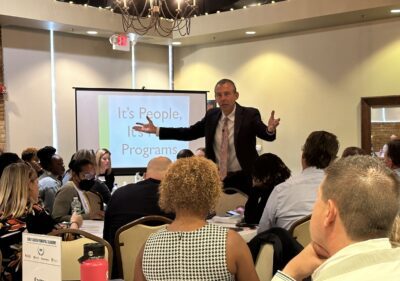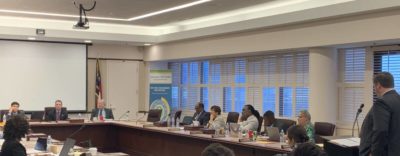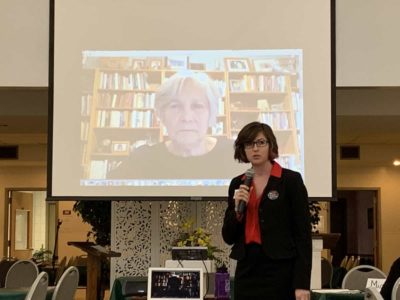
Jonathan Mooney hated school as a kid. He spent most of the day hanging out with the janitor in the hallway, avoiding classes. He would escape to the school bathroom with tears in his eyes, just so he wouldn’t be asked to read out loud. Diagnosed with dyslexia and dysgraphia in the third grade, and ADHD in the fourth, he felt as if he never quite fit in.
Some of his teachers felt the same way about him.
“Growing up, I had every label you could imagine,” Mooney said. “I was called the dumb kid. I was called the bad kid. I was called the lazy kid. And eventually, I became the special ed kid.”
Mooney tried special education schools and alternative schools. At age 11, he tried no school — dropping out for a while during sixth grade. At 12 years old, he still couldn’t read. His father told him he would most likely be a high school dropout. A counselor told him he would end up unemployed. One teacher told him he would wind up in jail. Illiterate and discouraged, he even made a plan for suicide.
Fast forward 10 years, and Mooney graduated with honors from Brown, an Ivy League university.
“How’d you do it? How did you go from a sixth-grade dropout who cannot read to an Ivy League graduate?” Mooney said, repeating the question he’s most often asked. What people really want to know, he added, is: “What drugs did you take, and where can I buy some?”
Mooney, who is an author and co-founder of Eye to Eye, was the keynote speaker this week at UNC’s 18th annual Burnett Seminar. His talk was designed to answer one question: How does a person who learns differently — because of specific learning disabilities such as dyslexia and attention issues — transcend a system that didn’t know how to teach him to find success? His answer:
- He stopped looking at himself as the problem.
- His mother advocated for his right to be taught the way he learns.
- And he found greater confidence by focusing on his strengths and talents.
“There’s a deeply held belief that these are deficiencies inside of a person — and for somebody with these deficiencies to be OK in the world, they’ve got to stop being different and fix their problem,” Mooney said. “But the reality is that these things are not deficiencies. They are differences. And they deserve not to be pathologized and fixed, but celebrated and included as a part of the continuum of human diversity.”
“It’s not the difference that’s the problem, it’s the way the difference is treated.”
Mooney started with a call to redefine who and what we call the problem, saying the education system erroneously puts the problem in the person. He remembers when his school counselor called his mother and him into her office to get his dyslexia diagnosis in third grade. His recollection was that everyone in the office stopped, stood silently, and watched he and his mom walk in with the counselor — as if to get tragic news.
“We were there to mourn the death of my normality,” he said.
But the mindset that normal is good is part of the problem. The language he encountered growing up planted the idea that he was deficient.
“But the reality is it’s a difference in the truest sense of word,” he said. “It’s a difference that comes with challenges, yes, but also with strengths and gifts that we don’t talk enough about.”
Mooney alluded to research that shows people with atypical attention are better problem solvers. But he doesn’t remember being celebrated as a problem solver. He remembers feeling imprisoned by a school desk and expected to sit still. Citing a RAND Corporation study saying that students spend, on average, 75% of their day sitting and listening, he challenged the idea that a child’s ability to comply with the mandate to sit still makes the student good or normal.
“The problem is not the person,” he said. “It’s a passive learning environment where kids sit still most of day. The problem is equating normal with good. And the problem is stigma and shame from being told you’re the problem.”
In one case, Mooney remembers encountering a child who was not only told he was the problem — he was treated like the problem. Mooney was visiting a classroom to deliver a talk in Wisconsin and noticed a makeshift box created out of bookshelves in the back of the room. He saw a head bobbing up and down and asked the teacher what was in the box.
“Oh, that’s Jack,” the teacher said, adding that Jack was being hyperactive.
Mooney’s first reaction: “You have a Jack in the box?”
His second reaction: “ADD ain’t Jack’s problem. The box is Jack’s problem.”
Mooney could relate to Jack. He understood the feeling that you have to conform to a pre-determined set of ideas and standards to be considered smart — and that failure to do so means you need to be fixed.
“We’ve all been acculturated into a world of norms that calls one brain smart, and the other brain not,” he said. “We all know what gets you in the smart group — and it ain’t your tactile kinesthetic intelligence; it ain’t your social emotional intelligence; it ain’t your verbal intelligence. It’s a narrow band of skills that we have decided to call smart. And that’s wrong.”
“If the student doesn’t learn the way they’re taught, teach the way the student learns.”
Mooney said that much of his early education experience felt like schools trying to fit him, a square peg, into a round hole.
“The problem is: If we try to fix the peg too much, if we try to jam that peg into the hole it doesn’t fit in, what happens to that person?” Mooney asked, before answering his own question.
“Eventually, they break,” he said. “We know now more than ever that being seen as deficient and subsequently being fixed all the time gives you the message that you are broken as a human being. And no human being thrives feeling broken.”
When the standardized methods of instruction were not working for her child, Mooney’s mother demanded that the school stop trying to change him and start finding ways for the instruction to change for him.
How can that be done? Mooney said we need to become advocates for a student’s right to learn differently. He spoke about individualized services and accommodations, many of which are free.
“If you have a different approach to reading,” he said, providing one example, “you need to be taught a way of reading that is aligned with your neurology.”
Mooney didn’t talk about the science of reading, specifically, but his thought lends itself to a growing body of research behind the teaching of structured literacy in classrooms as a benefit to students with dyslexia as well as the general education population.
Changing the way reading is taught can take time and require decision-making at district or state levels. Mooney focused on things parents and students could ask for in the classroom, including using text-to-speech to help with processing information, allowing a child to get up and move around, allowing extended time on tests and assignments, and allowing students to sit on an exercise ball instead of a chair.
Challenging the idea that using technology or extended time to assist with learning is cheating, Mooney used an analogy: Just like a student with a physical disability requires a ramp to access the school, a student with a learning disability requires accommodations and special services to access education.
“I needed accommodations for active learning,” he said. “I’m here because I had the chance to get up and pace back and forth in my AP English class. I’m here because I had a teacher who replaced my chair with an exercise ball. Why does that matter? Well, guess what, when I could bounce, I had more attention — and at the same time, I got a sweet ab workout.
“Those accommodations matter. And last but not least, I’m here because of accommodations around assessment. I had time extensions on exams. That matters because when you read in the 12th percentile and you get the same amount of time as everybody else, that ain’t fair. Time extensions level the playing field.”
Unless, he joked, we are raising a generation of contestants for “Jeopardy!”
Ideally, though, the system wouldn’t change to allow one or two students access to services or accommodations. Mooney wants to see universal design in schools, where the environment and curriculum are designed to reach every student by being more inclusive.
Dropping the deficit mindset
Mooney also attributed his success to focusing on his strengths and talents rather than his weaknesses. He recalled the pit in his stomach as he would work on spelling throughout the week. His teachers, he said, would sit down with him and try to help him “fix” his spelling. He also remembers how demoralized he felt every Friday after taking his spelling test.
No matter how hard he tried, he couldn’t learn it the way it was being taught. Every Friday a blow was delivered to his confidence with a poor spelling grade.
His confidence improved when a teacher said he’d been watching Mooney and thought Mooney was a great storyteller. The teacher identified a strength, named it, and encouraged Mooney — now the author of several books — to be a writer. He even told Mooney not to worry about spelling while in his class.
“It was the first time in my life somebody said, ‘Put aside what you can’t do, and focus on what you can do,'” Mooney said. “And every single student has that right. We got to flip that deficit model. And not only do we have to flip that deficit model rhetorically by talking about what’s right with kids, we have to flip that deficit model with where we spend our time.”
After seeing her son’s confidence drop with each poor spelling grade on Friday, Mooney’s mother had enough. One Friday, she told Mooney they were ditching school and going to the zoo. They learned about ecosystems. And every Friday for a year, Mooney and his mom ditched school and did something Mooney cared about. He loved to build, so they went to a construction site, and he learned about the relevance of math. Some Fridays they went to improv class, because Mooney had been getting detention for telling jokes and she wanted to foster his sense of comedy.
She called it “Get Good At Something Day.”
“We invested our time in building on something a kid was good at,” Mooney said. “I survived school because of Get Good At Something Day … If we’re real about it, we ain’t doing Get Good At Something Day at school. We’re doing Fix What’s Wrong With You. And, you know, people who thrive don’t get good at everything. They get good at something and they build a life around their passions, their interests, and their talents.
“Every single kid has something right with them. And my challenge to you is to find it, name it, and grow it.”
Recommended reading



